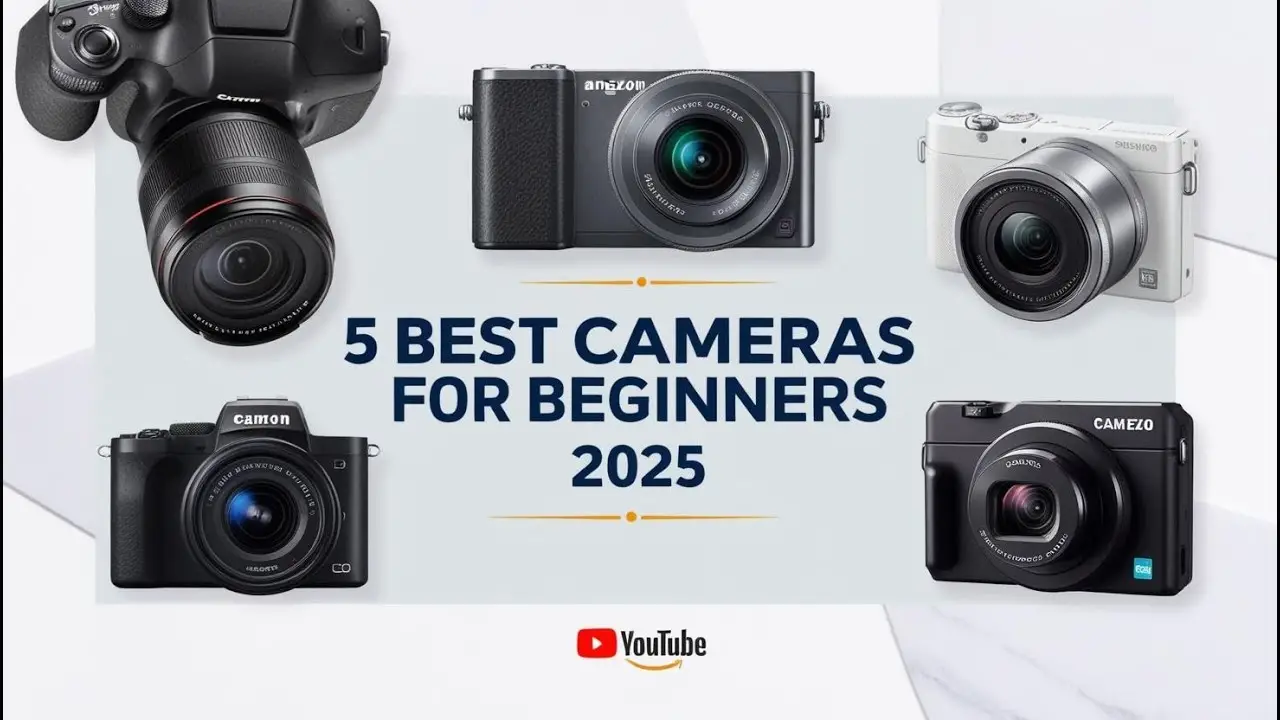Beginner Cameras: Top Picks for Aspiring Photographers in 2025
Introduction to Choosing a Beginner Camera
Selecting the right camera is a critical step for anyone starting their photography journey. For beginners, the camera serves not only as a tool but as a gateway to creative expression and skill development. A quality camera can significantly influence the learning experience; it empowers newcomers to explore their interests, experiment with different techniques, and ultimately build confidence in their craft. The right camera allows individuals to capture moments with clarity, enhancing their ability to convey stories through imagery, which can be incredibly motivating.
$1,036.95
$1,099.00
In recent years, technological advancements have revolutionized the photography landscape, making it more accessible to novices. The best cameras for beginners are now designed with user-friendly interfaces, automatic settings, and robust features that simplify the learning process. This evolution means that aspiring photographers can enjoy impressive photo quality without the burden of a hefty price tag. Cameras that were once deemed too complicated or expensive for entry-level users are now available at reasonable prices, providing excellent value for money.
Moreover, the emergence of compact and lightweight models has further enhanced accessibility, allowing beginners the flexibility to carry their cameras on various excursions. With the ability to shoot in diverse conditions and still achieve remarkable results, learners can experiment with their skills in different environments, amplifying their growth. By harnessing the power of modern technology, beginners can quickly advance from taking simply snapshot to creating stunning images that reflect their unique perspectives.
Thus, understanding the critical elements of a beginner camera is paramount. It can influence not only the quality of the photographs taken but also the enjoyment derived from the activity itself. As the photography realm continues to evolve, potential photographers should carefully consider their options to find the equipment that best suits their creative aspirations.
Understanding Camera Types
Choosing the right camera can significantly impact a beginner photographer’s experience and learning journey. There are several types of cameras available in the market, each designed with specific features that cater to different needs and preferences. The most common camera types include Digital Single-Lens Reflex (DSLR) cameras, mirrorless cameras, compact cameras, bridge cameras, and smartphones.
DSLR cameras are popular among photography enthusiasts due to their robust performance and versatility. They use a mirror and prism system to allow users to see exactly what the lens is capturing. DSLRs typically offer interchangeable lenses, extensive manual controls, and excellent image quality. However, they can be bulky and may have a steeper learning curve, making them less ideal for some beginners.
On the other hand, mirrorless cameras have emerged as a modern alternative to DSLRs. They maintain compactness by eliminating the mirror mechanism while still allowing for interchangeable lenses. Mirrorless cameras generally provide quick autofocus and advanced video capabilities, making them a great choice for those who seek both photography and videography features. However, battery life can be a concern since they rely heavily on electronic viewfinders.
Compact cameras, also known as point-and-shoot cameras, are compact and user-friendly, ideal for casual photography. They are lightweight, often featuring automatic settings that cater to straightforward shooting without complex controls. While they may not offer the same level of image quality as DSLRs or mirrorless cameras, compact cameras are convenient for beginners who prefer portability.
Bridge cameras offer a blend of features from DSLRs and compact cameras. They typically come with a fixed lens that covers a wide zoom range, which can be advantageous for beginner photographers exploring various styles. However, their lack of interchangeable lenses can limit creativity.
Lastly, smartphones have transformed photography by integrating powerful camera technology into everyday devices. Many smartphones now offer impressive camera capabilities with easy-to-use features, making them an accessible choice for beginners. However, they may lack the same level of control and image quality as dedicated cameras.
In summary, each type of camera has its own set of features, strengths, and weaknesses. By considering individual needs and preferences, beginner photographers can choose among the best cameras for beginners that suit their specific requirements.
Features to Look for in a Beginner Camera
Choosing the best cameras for beginners requires understanding the essential features that can significantly impact the quality of the photography experience. One of the primary elements to consider is the sensor size, as it directly influences image quality. Larger sensors typically capture more light, resulting in better performance in low-light conditions, richer colors, and overall improved image clarity. Beginners should seek cameras with at least an APS-C sensor size, as this strikes a balance between quality and manageable size.
Another critical feature is the autofocus system. An effective autofocus system is crucial for capturing sharp images, especially for moving subjects. Many modern beginner cameras come equipped with advanced autofocus technology, such as phase detection or on-sensor focus points, making the shooting experience more user-friendly. This is particularly important for aspiring photographers who may not yet be familiar with manual focus techniques.
Video capabilities are also essential, especially with the increasing demand for high-quality video content. For those interested in videography, selecting a camera that offers 4K recording is highly recommended. This feature allows for crisp and detailed video, elevating the overall production quality of any project. Ensuring that the camera has adequate video stabilization features can further enhance the video shooting experience.
User interface intuitiveness is another crucial aspect. Beginner cameras should have simple menus and controls that are easy to navigate, minimizing complexity and encouraging exploration of various settings. Additionally, the design and portability of the camera play important roles in usability. A lightweight and compact design makes it easier to carry the camera during excursions, promoting more spontaneous photography opportunities. These factors collectively contribute to a more enjoyable learning experience for novice photographers, helping them focus on creating stunning images.
Top 5 Best Cameras for Beginners in 2025
Choosing the right camera can be a challenging task for beginners, especially with the myriad of options available in the market. In 2025, several models stand out, offering user-friendly features, excellent performance, and versatility for a variety of photography styles. Here are five of the best cameras for beginners this year.
The Olympus OM-D E-M10 Mark V is a compelling choice due to its compact design and impressive capabilities. With a 20-megapixel sensor, in-body image stabilization, and a host of art filters, it enables novice photographers to experiment creatively while ensuring high image quality. Its intuitive controls and lightweight body make it suitable for both travel and everyday photography.
Another excellent option is the Canon EOS Rebel SL3, known for its ease of use and excellent Dual Pixel autofocus system. This DSLR features a 24.1-megapixel sensor and a vari-angle touchscreen, making it user-friendly for vloggers as well. Additionally, the camera’s built-in guided mode assists beginners in adjusting settings, which enhances the learning curve significantly.
The Sony ZV-E10 caters particularly to content creators and vloggers, with a 24.2-megapixel sensor and fast hybrid autofocus. Its versatile shooting modes and excellent low-light performance appeal to those interested in both stills and videos. The flip-out display is particularly advantageous for self-portrait photography.
Nikon ZFC brings a retro design combined with modern functionality. With a 20.9-megapixel sensor and robust video capabilities, this camera allows beginners to explore both photography and videography. Its user-friendly interface and classic controls enhance the shooting experience, making it perfect for those who appreciate a vintage aesthetic.
Finally, the Canon EOS R10 provides a seamless transition for those looking to step into the mirrorless realm. With a 24.2-megapixel sensor, rapid autofocus, and continuous shooting capabilities, it serves well for action photography as well as landscapes. The camera’s compact size promotes portability, making it ideal for novice photographers on the go.
These five cameras—Olympus OM-D E-M10 Mark V, Canon EOS Rebel SL3, Sony ZV-E10, Nikon ZFC, and Canon EOS R10—represent the best choices for beginners in 2025, combining ease of use, powerful features, and versatility. By selecting any of these models, novices will be well-equipped to embark on their photography journey.
$1,036.95
$1,099.00
Comparison of Camera Features
When choosing the best cameras for beginners, it’s essential to evaluate their key features to identify which model aligns with personal photography goals. This comparative analysis examines critical aspects such as image quality, video performance, and overall usability, ensuring newcomers to photography can make an informed decision.
Image quality plays a crucial role in the selection of a camera. The best cameras for beginners typically possess sensors that deliver high-resolution images, essential for capturing detail and clarity. For instance, cameras equipped with APS-C or Micro Four Thirds sensors generally provide superior image quality compared to those with smaller sensors. The color accuracy and low-light performance are also pivotal; some models utilize advanced technology to enhance image quality under challenging lighting conditions, making them more appealing for aspiring photographers.
Video performance is increasingly a significant consideration for many beginners. As they venture into videography, cameras with 4K video capabilities and improved autofocus systems are becoming more sought after. The best beginner cameras often include features like in-body stabilization, which helps in achieving smooth video footage. Additionally, the option to utilize external microphones or headphone jacks enhances audio capture, a crucial factor for achieving professional results in video recordings.
Overall usability is another fundamental aspect that defines the best cameras for beginners. Cameras with intuitive layouts, touchscreen interfaces, and automatic settings simplify the learning curve, allowing novices to focus on composition rather than technicalities. Moreover, the availability of various shooting modes and connectivity options, such as Wi-Fi or Bluetooth, increase convenience when transferring images or controlling the camera remotely.
The comparison between these essential features allows beginners to evaluate which camera suits their individual photography style, ensuring they invest in a product that will effectively support their journey into the world of photography.
Tips for Beginners on Using a Camera
For those venturing into photography, understanding the fundamental aspects of your camera can significantly enhance your experience and results. When selecting from the best cameras for beginners, it’s vital to grasp three core components: exposure, composition, and lighting. These elements form the foundation of photography, allowing beginners to capture captivating images.
Exposure is determined by three key settings: ISO, aperture, and shutter speed. ISO refers to the camera’s sensitivity to light; a higher ISO allows for shooting in dim conditions but can introduce noise. Aperture, denoted by f-stop numbers, controls the depth of field and the amount of light entering the lens. A lower f-stop creates a blurred background, emphasizing the subject, whereas a higher f-stop keeps more of the scene in focus. Shutter speed dictates how long the camera’s sensor is exposed to light. Faster shutter speeds freeze motion, while slower speeds can create artistic effects like motion blur. Mastering exposure settings enables beginners to adjust their cameras according to different shooting environments and creative intentions.
Composition is equally critical in photography. Learning techniques such as the rule of thirds, leading lines, and framing can dramatically alter how an image is perceived. The rule of thirds suggests placing the subject off-center to create a more balanced composition, while leading lines guide the viewer’s eye toward the subject. Utilizing natural frames, such as doors or branches, can also add depth and focus to your photographs.
Lastly, understanding the impact of lighting is essential for taking great pictures. Natural light often yields the best results, particularly during the golden hours – shortly after sunrise and before sunset. Experimenting with different lighting conditions will help beginners to recognize the nuances of shadows and highlights.
By focusing on these key areas, beginner photographers can take full advantage of the best cameras for beginners, allowing them to produce stunning images with practice and exploration.
Hands-On Practice is Essential
For novice photographers navigating the world of photography, one of the most effective ways to master their craft is through hands-on experience. Owning one of the best cameras for beginners is just the first step; actually using the camera in various settings will foster skill development and a deeper understanding of photographic techniques. It is highly recommended that beginners take their cameras outdoors regularly, whether it be for capturing scenic landscapes, candid portraits, or dynamic street photography. Each session offers an opportunity to experiment with different settings, angles, and lighting conditions.
Leveraging Online Resources
In addition to practical experience, online tutorials can offer a wealth of knowledge for new photographers. Platforms such as YouTube host countless instructional videos that cover everything from the fundamentals of camera operation to complex editing techniques. By exploring these resources, beginners can gain insights into utilizing their cameras effectively, and learn how to make the most of the features available in the best cameras for beginners. Furthermore, participating in online photography courses can also provide structure to their learning process, ensuring they grasp key concepts at a comfortable pace.
Engaging with Photography Communities
Another significant aspect of a beginner’s photographic journey is connecting with other enthusiasts. Online forums, social media groups, and local clubs are fantastic spaces to share experiences, seek feedback, and gather inspiration. Engaging with a community allows beginners to learn from the successes and mistakes of others, while also fostering a sense of belonging within the sphere of photography. These interactions can lead to constructive critiques that enable new photographers to refine their skills and approach. In conclusion, combining hands-on practice, online education, and community engagement will not only bolster a beginner’s confidence but also enhance their overall photography experience.
$739.95
$19.99
$7.99
$299.99
$1,036.95
$1,099.00
Mistakes to Avoid
Embarking on a photography journey can be both exhilarating and daunting, especially for beginners. However, there are several common mistakes that can hinder progress and enjoyment in this creative field. Understanding these pitfalls can lead to a more fulfilling experience with the best cameras for beginners.
One significant mistake that novice photographers often make involves lens selection. Many beginners may prioritize purchasing the latest camera body while overlooking the importance of a versatile lens. The lens significantly impacts image quality and versatility; for example, a good kit lens can serve various purposes, whereas specialized lenses might not always be necessary. By taking time to understand the different types of lenses available and their respective advantages, beginners can enhance their photographic capabilities and achieve more impressive results.
Another frequent oversight is neglecting to read the camera manual thoroughly. While it may seem tedious, the manual provides valuable information on how to make the most of the camera’s features and settings. Each camera, even among the best cameras for beginners, has unique functionalities that can greatly enhance the image-making process. Familiarizing oneself with these features enables users to utilize their equipment effectively, leading to improved photographs and a deeper understanding of photographic principles.
Additionally, many beginners fall into the trap of focusing on gear rather than honing their photography techniques. It is not uncommon for newcomers to invest heavily in equipment, believing that the best cameras for beginners and additional accessories will automatically lead to better photos. However, mastering the basic principles of photography—such as composition, lighting, and exposure—is far more important. Prioritizing skill development over constant upgrades fosters a more rewarding photographic journey and builds a strong foundation for future growth.
By avoiding these common mistakes—mindful lens selection, diligent study of one’s camera manual, and prioritizing skill over gear—beginning photographers can more effectively navigate their journey in the world of photography.
Frequently Asked Questions
When venturing into photography, many beginners often have numerous questions regarding the best cameras for beginners. One of the most common inquiries is about how much to spend on the first camera. Generally, a budget between $400 to $800 can secure a decent entry-level camera, providing quality features without overwhelming the user.
Another crucial consideration for budding photographers is whether to invest in additional lenses early in their photography journey. While starting with a standard kit lens is advisable, investing in a versatile lens, such as a 50mm prime or a stabilizing zoom lens, can enhance one’s ability to capture various types of photographs. Such an investment can be worthwhile, as it allows for greater creative flexibility and improved image quality.
A frequent question pertains to the feasibility of learning photography solely via smartphone. While smartphones have advanced in quality and functionality, transitioning to a dedicated camera can significantly enhance one’s photography skills. Cameras designed for beginners typically feature manual controls, larger sensors, and improved optics, offering more creative control and better results in varied lighting conditions.
Starting settings can also be a source of confusion for newcomers. It is recommended to initially explore shooting in Aperture Priority mode, which allows control over depth of field while the camera automatically adjusts shutter speed. This can be a great way to understand the relationship between exposure settings without becoming overwhelmed.
Lastly, many beginners wonder about efficiently transferring photos to a computer. Most modern cameras have USB ports or Wi-Fi capabilities that simplify this process. Using camera-specific software can also streamline transfers, allowing for easy photo organization and editing, enhancing the overall learning experience.
Conclusion
Throughout this exploration of the top 5 best cameras for beginners in 2025, we have delved into various models that cater specifically to novice photographers. Each camera highlighted provides unique features that facilitate a smoother learning curve, allowing new users to become acquainted with essential photography concepts. Whether considering functionalities such as automatic settings, user-friendly interfaces, or lightweight designs, these options are tailored to assist beginners in building their skills without overwhelming them.
However, it is crucial to acknowledge that while choosing the right equipment is undeniably important, the foundation of becoming a proficient photographer lies in gaining experience and practice. The best cameras for beginners can enhance the shooting experience, but true progress comes from actively engaging with the craft. Photographers must experiment with different settings, explore various subjects, and take the time to understand light and composition in order to develop their unique style.
Embracing the learning journey is essential; every click of the shutter represents a step forward in mastering the art of photography. As beginners embark on their photographic adventures, it is advisable to celebrate both successes and failures, as each contributes to personal growth in this artistic field. By practicing regularly and being open to constructive feedback, new photographers will find themselves improving steadily over time. Ultimately, the joy of capturing the world through a lens is a fulfilling endeavor that combines both technical skill and creative expression. The insights offered in this blog post should serve as a guide, empowering novices to confidently take their first steps into the vast world of photography.
$1,036.95
$1,099.00
$739.95
$19.99
$7.99
$299.99




















![Screen Protector Appliable for Olympus OM-D E-M10 Mark IV Camera & Hot Shoe Cover 0.3mm 9H Hardness Tempered Glass Flim, Anti-Scrach Anti-Fingerprint [3Pack]](https://m.media-amazon.com/images/I/61GB0Vbmp8L._AC_SL1000_.jpg)


![AKWOX (Pack of 3) Tempered Screen Protector For Olympus OM-D E-M10 Mark III II E-M5 MARK II PEN-F E-P5 E-PL8 E-PL7 E-PL9, [0.3mm 2.5D High Definition 9H] Optical LCD Premium Glass Protective Cover](https://m.media-amazon.com/images/I/617R4srrhqL._AC_SL1200_.jpg)




